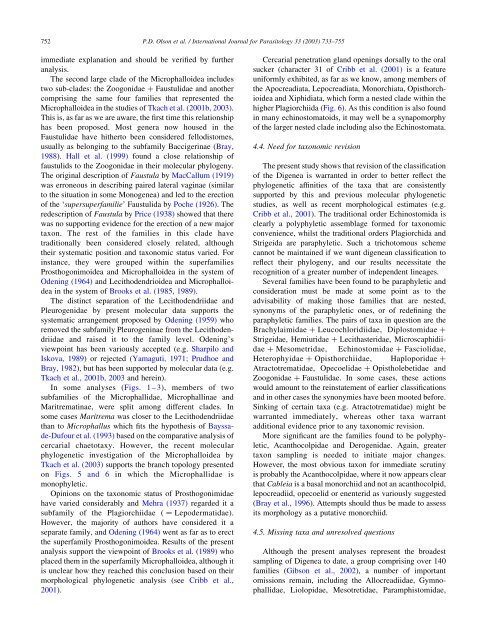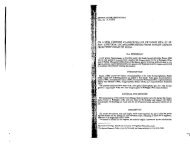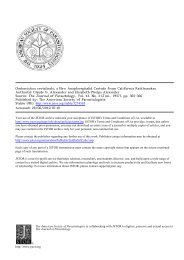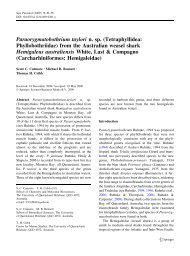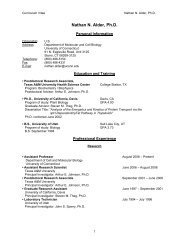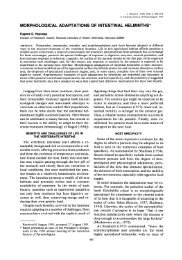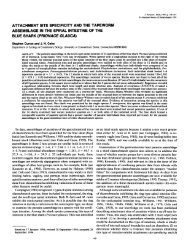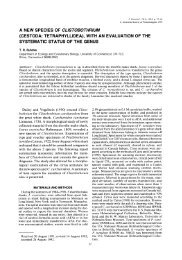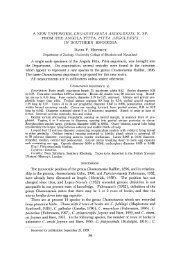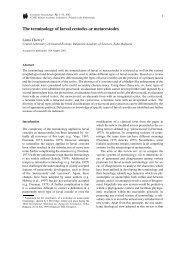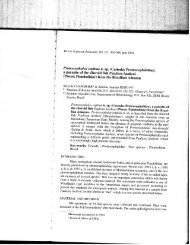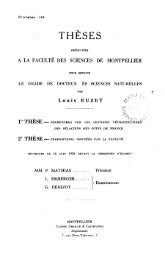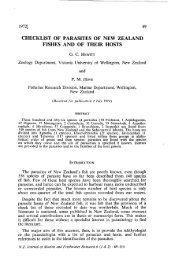Phylogeny and classification of the Digenea (Platyhelminthes ...
Phylogeny and classification of the Digenea (Platyhelminthes ...
Phylogeny and classification of the Digenea (Platyhelminthes ...
Create successful ePaper yourself
Turn your PDF publications into a flip-book with our unique Google optimized e-Paper software.
752P.D. Olson et al. / International Journal for Parasitology 33 (2003) 733–755immediate explanation <strong>and</strong> should be verified by fur<strong>the</strong>ranalysis.The second large clade <strong>of</strong> <strong>the</strong> Microphalloidea includestwo sub-clades: <strong>the</strong> Zoogonidae þ Faustulidae <strong>and</strong> ano<strong>the</strong>rcomprising <strong>the</strong> same four families that represented <strong>the</strong>Microphalloidea in <strong>the</strong> studies <strong>of</strong> Tkach et al. (2001b, 2003).This is, as far as we are aware, <strong>the</strong> first time this relationshiphas been proposed. Most genera now housed in <strong>the</strong>Faustulidae have hi<strong>the</strong>rto been considered fellodistomes,usually as belonging to <strong>the</strong> subfamily Baccigerinae (Bray,1988). Hall et al. (1999) found a close relationship <strong>of</strong>faustulids to <strong>the</strong> Zoogonidae in <strong>the</strong>ir molecular phylogeny.The original description <strong>of</strong> Faustula by MacCallum (1919)was erroneous in describing paired lateral vaginae (similarto <strong>the</strong> situation in some Monogenea) <strong>and</strong> led to <strong>the</strong> erection<strong>of</strong> <strong>the</strong> ‘supersuperfamilie’ Faustulida by Poche (1926). Theredescription <strong>of</strong> Faustula by Price (1938) showed that <strong>the</strong>rewas no supporting evidence for <strong>the</strong> erection <strong>of</strong> a new majortaxon. The rest <strong>of</strong> <strong>the</strong> families in this clade havetraditionally been considered closely related, although<strong>the</strong>ir systematic position <strong>and</strong> taxonomic status varied. Forinstance, <strong>the</strong>y were grouped within <strong>the</strong> superfamiliesProsthogonimoidea <strong>and</strong> Microphalloidea in <strong>the</strong> system <strong>of</strong>Odening (1964) <strong>and</strong> Lecithodendrioidea <strong>and</strong> Microphalloideain <strong>the</strong> system <strong>of</strong> Brooks et al. (1985, 1989).The distinct separation <strong>of</strong> <strong>the</strong> Lecithodendriidae <strong>and</strong>Pleurogenidae by present molecular data supports <strong>the</strong>systematic arrangement proposed by Odening (1959) whoremoved <strong>the</strong> subfamily Pleurogeninae from <strong>the</strong> Lecithodendriidae<strong>and</strong> raised it to <strong>the</strong> family level. Odening’sviewpoint has been variously accepted (e.g. Sharpilo <strong>and</strong>Iskova, 1989) or rejected (Yamaguti, 1971; Prudhoe <strong>and</strong>Bray, 1982), but has been supported by molecular data (e.g.Tkach et al., 2001b, 2003 <strong>and</strong> herein).In some analyses (Figs. 1– 3), members <strong>of</strong> twosubfamilies <strong>of</strong> <strong>the</strong> Microphallidae, Microphallinae <strong>and</strong>Maritrematinae, were split among different clades. Insome cases Maritrema was closer to <strong>the</strong> Lecithodendriidaethan to Microphallus which fits <strong>the</strong> hypo<strong>the</strong>sis <strong>of</strong> Bayssade-Dufouret al. (1993) based on <strong>the</strong> comparative analysis <strong>of</strong>cercarial chaetotaxy. However, <strong>the</strong> recent molecularphylogenetic investigation <strong>of</strong> <strong>the</strong> Microphalloidea byTkach et al. (2003) supports <strong>the</strong> branch topology presentedon Figs. 5 <strong>and</strong> 6 in which <strong>the</strong> Microphallidae ismonophyletic.Opinions on <strong>the</strong> taxonomic status <strong>of</strong> Prosthogonimidaehave varied considerably <strong>and</strong> Mehra (1937) regarded it asubfamily <strong>of</strong> <strong>the</strong> Plagiorchiidae ( ¼ Lepodermatidae).However, <strong>the</strong> majority <strong>of</strong> authors have considered it aseparate family, <strong>and</strong> Odening (1964) went as far as to erect<strong>the</strong> superfamily Prosthogonimoidea. Results <strong>of</strong> <strong>the</strong> presentanalysis support <strong>the</strong> viewpoint <strong>of</strong> Brooks et al. (1989) whoplaced <strong>the</strong>m in <strong>the</strong> superfamily Microphalloidea, although itis unclear how <strong>the</strong>y reached this conclusion based on <strong>the</strong>irmorphological phylogenetic analysis (see Cribb et al.,2001).Cercarial penetration gl<strong>and</strong> openings dorsally to <strong>the</strong> oralsucker (character 31 <strong>of</strong> Cribb et al. (2001) is a featureuniformly exhibited, as far as we know, among members <strong>of</strong><strong>the</strong> Apocreadiata, Lepocreadiata, Monorchiata, Opisthorchioidea<strong>and</strong> Xiphidiata, which form a nested clade within <strong>the</strong>higher Plagiorchiida (Fig. 6). As this condition is also foundin many echinostomatoids, it may well be a synapomorphy<strong>of</strong> <strong>the</strong> larger nested clade including also <strong>the</strong> Echinostomata.4.4. Need for taxonomic revisionThe present study shows that revision <strong>of</strong> <strong>the</strong> <strong>classification</strong><strong>of</strong> <strong>the</strong> <strong>Digenea</strong> is warranted in order to better reflect <strong>the</strong>phylogenetic affinities <strong>of</strong> <strong>the</strong> taxa that are consistentlysupported by this <strong>and</strong> previous molecular phylogeneticstudies, as well as recent morphological estimates (e.g.Cribb et al., 2001). The traditional order Echinostomida isclearly a polyphyletic assemblage formed for taxonomicconvenience, whilst <strong>the</strong> traditional orders Plagiorchida <strong>and</strong>Strigeida are paraphyletic. Such a trichotomous schemecannot be maintained if we want digenean <strong>classification</strong> toreflect <strong>the</strong>ir phylogeny, <strong>and</strong> our results necessitate <strong>the</strong>recognition <strong>of</strong> a greater number <strong>of</strong> independent lineages.Several families have been found to be paraphyletic <strong>and</strong>consideration must be made at some point as to <strong>the</strong>advisability <strong>of</strong> making those families that are nested,synonyms <strong>of</strong> <strong>the</strong> paraphyletic ones, or <strong>of</strong> redefining <strong>the</strong>paraphyletic families. The pairs <strong>of</strong> taxa in question are <strong>the</strong>Brachylaimidae þ Leucochloridiidae, Diplostomidae þStrigeidae, Hemiuridae þ Lecithasteridae, Microscaphidiidaeþ Mesometridae, Echinostomidae þ Fasciolidae,Heterophyidae þ Opisthorchiidae, Haploporidae þAtractotrematidae, Opecoelidae þ Opistholebetidae <strong>and</strong>Zoogonidae þ Faustulidae. In some cases, <strong>the</strong>se actionswould amount to <strong>the</strong> reinstatement <strong>of</strong> earlier <strong>classification</strong>s<strong>and</strong> in o<strong>the</strong>r cases <strong>the</strong> synonymies have been mooted before.Sinking <strong>of</strong> certain taxa (e.g. Atractotrematidae) might bewarranted immediately, whereas o<strong>the</strong>r taxa warrantadditional evidence prior to any taxonomic revision.More significant are <strong>the</strong> families found to be polyphyletic,Acanthocolpidae <strong>and</strong> Derogenidae. Again, greatertaxon sampling is needed to initiate major changes.However, <strong>the</strong> most obvious taxon for immediate scrutinyis probably <strong>the</strong> Acanthocolpidae, where it now appears clearthat Cableia is a basal monorchiid <strong>and</strong> not an acanthocolpid,lepocreadiid, opecoelid or enenterid as variously suggested(Bray et al., 1996). Attempts should thus be made to assessits morphology as a putative monorchiid.4.5. Missing taxa <strong>and</strong> unresolved questionsAlthough <strong>the</strong> present analyses represent <strong>the</strong> broadestsampling <strong>of</strong> <strong>Digenea</strong> to date, a group comprising over 140families (Gibson et al., 2002), a number <strong>of</strong> importantomissions remain, including <strong>the</strong> Allocreadiidae, Gymnophallidae,Liolopidae, Mesotretidae, Paramphistomidae,


